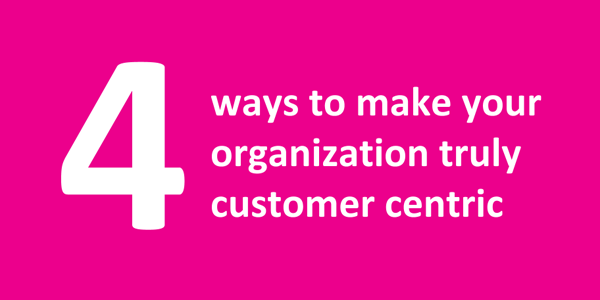How to make your organization truly customer centric

We all know that today it’s vital to put customers at the heart of your business. However, there are many companies that believe in this principle, but struggle to successfully ‘live it’ in practice, day-in, day-out.
How do you become more customer centric? There are multiple aspects to this, from making a customer focus part of your company vision and objectives, prioritizing it in recruitment and training plans, implementing technology and processes to support it, and even linking customer centricity to company bonuses.
At a recent Gartner event, analysts Olive Huang and Jenny Sussin ran through 10 key areas to help establish customer centricity into your brand. I am going to focus on four of them here.
1. Building customer empathy
Customers want to be understood and treated well by companies that empathize with them and their needs. But creating this customer understanding is complicated by the fact that the customer journey today is fluid and spans numerous touchpoints, many of them digital channels.
Therefore, make sure you are delivering a joined-up experience in which every touchpoint is informed by customers’ previous interactions and history with your company (across all channels). This way they feel understood and don’t have to repeat themselves when they move between channels.
You can demonstrate understanding by being timely and helpful, and this can be greatly enhanced with the help of Artificial Intelligence (AI) and Natural Language Processing (NLP). Incoming digital interactions are automatically analyzed and forwarded to the best person to answer them and the agent provided with both an idea of the nature of the query and the tone - is she angry or upset, for example? This helps the agent focus on building a human, empathetic relationship that drives loyalty.
2. Sharing knowledge
Gartner predicts that by 2020 10% of business-to-consumer first-level engagement requests will be taken by virtual customer service agents, such as chatbots, up from just 1% today. But whatever the channel is, and whether answers are provided by chatbots or people, it is vital that up-to- date, accurate information is available to every channel to drive consistency, accuracy and efficiency.
To achieve this put in place a single, centralized, comprehensive knowledge base that underpins self-service, chatbots and your agents. And make it easy to use, easy to update and self-learning so it automatically delivers the most relevant answers to customer queries.
3. Acting systematically to continuously improve the experience
CX is a journey, not a destination. Consumer expectations are always rising, competition is increasing and technology is always moving forward. So you can’t stand still. Have a plan and ensure you are always looking at the next opportunities.
It is too important not to have a strategic plan to address continuous improvement. So look at putting in place a methodology to help you identify where things can be made better and how. This can cover everything from analyzing customer satisfaction levels for different parts of the journey, gathering employee feedback to learn where improvements are needed, complaints monitoring to identify pain-points, competitor tracking and gathering business intelligence about market innovation and trends.
4. Creating accountability for CX improvements
Often today, responsibility for the customer experience is spread over multiple departments. In one Gartner study a wide variety of departments, from marketing, sales, operations, supply chain and IT to dedicated customer experience teams were shown to have either primary or secondary responsibility for the customer experience.
This lack of clear accountability makes it difficult to maintain high standards and drive through improvements because no one is ultimately responsible. And no one has the power to execute change.
This is why CX needs to be led from the top and why some companies are hiring a Chief Customer Officer (CCO). This is an empowered, senior level appointment, who stands outside of other departments and has the experience and understanding to manage customer experience. Whether you opt to bring in a CCO or not, you must ensure that CX gets the oversight it requires.
Today, the balance of power has shifted firmly in favor of the customer. The companies that succeed will be those that put the customer first. This includes creating a joined-up experience that prioritizes customer empathy and knowledge sharing, with strong accountable leadership and an emphasis on continuous improvement.






